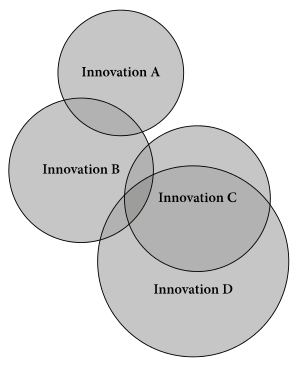This article needs additional citations for verification. (January 2012) |

In historical linguistics, the wave model or wave theory (German: Wellentheorie) is a model of language change in which a new language feature (innovation) or a new combination of language features spreads from its region of origin, being adopted by a gradually expanding cluster of dialects. Each innovation starts at a certain place, and spreads from speaker to speaker, from dialect to dialect, in the same fashion as waves on the water.[1][2]
The theory was intended as a substitute for the tree model, which did not seem to be able to explain the existence of some features, especially in the Germanic languages, by descent from a proto-language. At its most ambitious, it is a wholesale replacement for the tree model of languages.[2] During the 20th century, the wave model had little acceptance as a model for language change overall, except for certain cases, such as the study of dialect continua and areal phenomena; it has recently gained more popularity among historical linguists, due to the shortcomings of the tree model.[2][3]
- ^ Cite error: The named reference
Wolframwas invoked but never defined (see the help page). - ^ a b c Cite error: The named reference
francoiswas invoked but never defined (see the help page). - ^ Heggarty, Paul; Maguire, Warren; McMahon, April (2010). "Splits or waves? Trees or webs? How divergence measures and network analysis can unravel language histories". Philosophical Transactions of the Royal Society B. 365 (1559): 3829–3843. doi:10.1098/rstb.2010.0099. PMC 2981917. PMID 21041208..